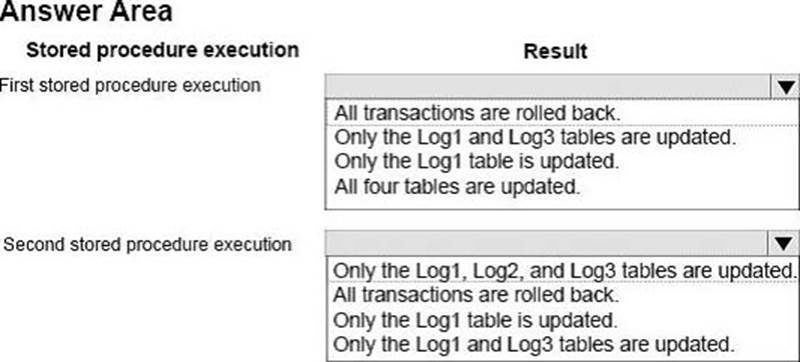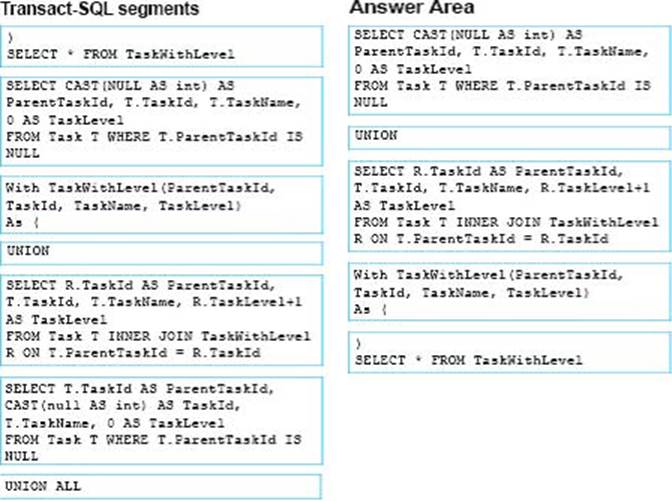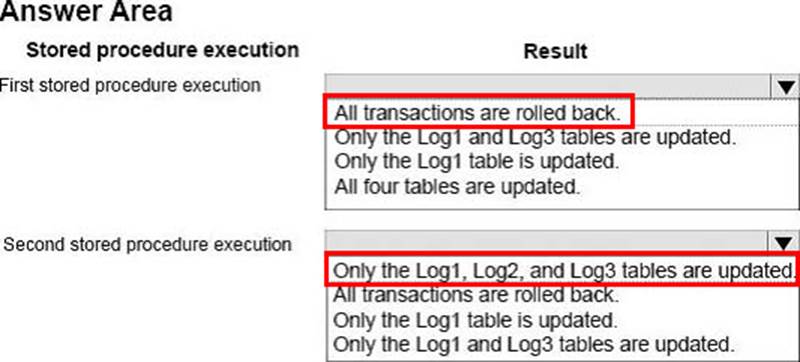Microsoft 70-761 Querying Data with Transact-SQL Online Training
Microsoft 70-761 Online Training
The questions for 70-761 were last updated at Feb 20,2025.
- Exam Code: 70-761
- Exam Name: Querying Data with Transact-SQL
- Certification Provider: Microsoft
- Latest update: Feb 20,2025
HOTSPOT
Note: This question is part of a series of questions that use the same scenario. For your convenience, the scenario is repeated in each question. Each question presents a different goal and answer choices, but the text of the scenario is exactly the same in each question in this series.
You query a database that includes two tables: Projectand Task.
The Project table includes the following columns:

The Task table includes the following columns:

You need to identify the owner of each task by using the following rules:
– Return each task’s owner if the task has an owner.
– If a task has no owner, but is associated with a project that has an owner, return the project’s owner.
– Return the value-1for all other cases.
How should you complete the Transact-SQL statement? To answer, select the appropriate Transact-SQL segments in the answer area.

DRAG DROP
Note: This question is part of a series of questions that use the same scenario. For your convenience, the scenario is repeated in each question. Each question presents a different goal and answer choices, but the text of the scenario is exactly the same in each question in this series.
You query a database that includes two tables: Project and Task.
The Project table includes the following columns:

The Task table includes the following columns:

Task level is defined using the following rules:

You need to determine the task level for each task in the hierarchy.
Which five Transact-SQL segments should you use to develop the solution? To answer, move the appropriate Transact-SQL segments from the list of Transact-SQL segments to the answer area and arrange them in the correct order.

DRAG DROP
Note: This question is part of a series of questions that use the same scenario. For your convenience, the scenario is repeated in each question. Each question presents a different goal and answer choices, but the text of the scenario is exactly the same in each question in this series.
You query a database that includes two tables: Project and Task.
The Project table includes the following columns:

The Task table includes the following columns:

When running an operation, you updated a column named EndTime for several records in the Project table, but updates to the corresponding task records in the Task table failed.
You need to synchronize the value of the EndTime column in the Task table with the value of the EndTime column in the project table.
The solution must meet the following requirements:
– If the EndTime column has a value, make no changes to the record.
– If the value of the EndTime column is null and the corresponding project record is marked as completed, update the record with the project finish time.
Which four Transact-SQL segments should you use to develop the solution? To answer, move the appropriate Transact-SQL segments from the list of Transact-SQL segments to the answer area and arrange them in the correct order.

You need to create a database object that meets the following requirements:
– accepts a product identified as input
– calculates the total quantity of a specific product, including quantity on hand and quantity on order
– caches and reuses execution plans
– returns a value
– can be called from within a SELECT statement
– can be used in a JOIN clause
What should you create?
- A . an extended stored procedure
- B . a user-defined scalar function
- C . a user-defined stored procedure that has an OUTPUT parameter
- D . a temporary table that has a columnstore index
HOTSPOT
You have the following stored procedure:

You run the following Transact-SQL statements:
![]()
What is the result of each Transact-SQL statement? To answer, select the appropriate options in the answer area.

HOTSPOT
You need to develop a Transact-SQL statement that meets the following requirements:
– The statement must return a custom error when there are problems updating a table.
– The error number must be value50555.
– The error severity level must be14.
– A Microsoft SQL Server alert must be triggered when the error condition occurs.
Which Transact-SQL segment should you use for each requirement? To answer, select the appropriate Transact-SQL segments in the answer area.

DRAG DROP
You need to create a stored procedure to update a table named Sales.Customers.
The structure of the table is shown in the exhibit. (Click the exhibit button.)

The stored procedure must meet the following requirements:
– Accept two input parameters.
– Update the company name if the customer exists.
– Return a custom error message if the customer does not exist.
Which five Transact-SQL segments should you use to develop the solution? To answer, move the appropriate Transact-SQL segments from the list of Transact-SQL segments to the answer area and arrange them in the correct order. NOTE: More than one order of answer choices is correct. You will receive credit for any of the correct orders you select.

You need to create an indexed view that requires logic statements to manipulate the data that the view displays.
Which two database objects should you use? Each correct answer presents a complete solution.
- A . a user-defined table-valued function
- B . a CRL function
- C . a stored procedure
- D . a user-defined scalar function
DRAG DROP
You have two tables named UserLogin and Employee respectively.
You need to create a Transact-SQL script that meets the following requirements:
– The script must update the value of the IsDeleted column for the UserLogin table to 1 if the value of the Id column for the User Login table is equal to 1.
– The script must update the value of the IsDeleted column of the Employee table to 1 if the value of the Id column is equal to 1 for the Employee table when an update to the User Login table throws an error.
– The error message "No tables updated!" must be produced when an update to the Employee table throws an error.
Which five Transact-SQL segments should you use to develop the solution? To answer, move the appropriate Transact-SQL segments from the list of Transact-SQL segments to the answerarea and arrange them in the correct order.

SIMULATION
You work for an organization that monitors seismic activity around volcanos. You have a table named GroundSensors. The table stores data collected from seismic sensors that measure earthquake activity.
It includes the columns described in the following table:

The database also contains a scalar value function named NearestMountain that returns the name of the mountain that is nearest to the sensor.
You need to create a query that shows the average of the normalized readings from the sensors for each mountain.
The query must meet the following requirements:
– Include the average normalized readings and nearest mountain name.
– Exclude sensors for which no normalized reading exists.
– Exclude those sensors with value of zero for tremor.
Construct the query using the following guidelines:
– Use one part names to reference tables, columns and functions.
– Do not use parentheses unless required.
– Do not use aliases for column names and table names.
– Do not surround object names with square brackets.

Part of the correct Transact-SQL has been provided in the answer area below. Enter the code in the answer area that resolves the problem and meets the stated goals or requirements. You can add code within the code that has been provided as well as below it.
![]()
Use the Check Syntax button to verify your work. Any syntax or spelling errors will be reported by line and character position.
Latest 70-761 Dumps Valid Version with 212 Q&As
Latest And Valid Q&A | Instant Download | Once Fail, Full Refund








